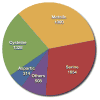Sequence-derived structural features driving proteolytic processing
- PMID: 24227478
- PMCID: PMC3926948
- DOI: 10.1002/pmic.201300416
Sequence-derived structural features driving proteolytic processing
Abstract
Proteolytic signaling, or regulated proteolysis, is an essential part of many important pathways such as Notch, Wnt, and Hedgehog. How the structure of the cleaved substrate regions influences the efficacy of proteolytic processing remains underexplored. Here, we analyzed the relative importance in proteolysis of various structural features derived from substrate sequences using a dataset of more than 5000 experimentally verified proteolytic events captured in CutDB. Accessibility to the solvent was recognized as an essential property of a proteolytically processed polypeptide chain. Proteolytic events were found nearly uniformly distributed among three types of secondary structure, although with some enrichment in loops. Cleavages in α-helices were found to be relatively abundant in regions apparently prone to unfolding, while cleavages in β-structures tended to be located at the periphery of β-sheets. Application of the same statistical procedures to proteolytic events divided into separate sets according to the catalytic classes of proteases proved consistency of the results and confirmed that the structural mechanisms of proteolysis are universal. The estimated prediction power of sequence-derived structural features, which turned out to be sufficiently high, presents a rationale for their use in bioinformatic prediction of proteolytic events.
Keywords: Bioinformatics; Cleavage site; Limited proteolysis; Protease; Proteolytic processing; Regulated proteolysis.
© 2013 WILEY-VCH Verlag GmbH & Co. KGaA, Weinheim.
Figures
References
-
- Barrett AJ, Rawlings ND, Woessner JM. Handbook of Proteolytic Enzymes: Cysteine, serine and threonine peptidases. Vol. 2. Elsevier Acad. Press; 2004.
-
- Turk B. Targeting proteases: successes, failures and future prospects. Nat Rev Drug Discov. 2006;5:785–799. - PubMed
-
- Lopez-Otin C, Overall CM. Protease degradomics: a new challenge for proteomics. Nat Rev Mol Cell Biol. 2002;3:509–519. - PubMed
Publication types
MeSH terms
Substances
Grants and funding
LinkOut - more resources
Full Text Sources
Other Literature Sources








